Creating an inclusive and engaging employee experience is difficult at the best of times, but is becoming even more challenging as organizations transition to more flexible work. Connecting and collaborating with a mix of remote, mobile, part-time, shift-based or socially distanced employees across multiple locations and time zones is becoming increasingly difficult for organizations of all sizes.
 The questions I’m most asked when I speak to HR leaders is how organizations can best support their people as they lead them through this changing, unpredictable environment.
The questions I’m most asked when I speak to HR leaders is how organizations can best support their people as they lead them through this changing, unpredictable environment.
And from there, how do we create an environment that fuels both stability and agility? How can you cultivate connection while prioritizing growth? How do we avoid work becoming overly transactional and help our people transition in-office interactions to a digital environment? How do we amplify progress and celebrate wins if we aren’t seeing them happen?
Thankfully, I can see the advantages that the organizations we partner with have when it comes to being able to leverage technology to cultivate connection, culture and employee wellbeing. Our recent study showed that employees who said their company has handled COVID-19 well indicated they believe this is a result of:
| 1. Having the right tools and technologies in place |
| 2. Maintaining regular communication |
| 3. Taking steps to ensure employee wellbeing |
Employers who design their people platforms to create meaningful touch points throughout the employee experience unlock the key to maintaining long-term engagement and productivity — at speed and with scale.
Leveraging employee engagement technology allows organizations to integrate regular, open, honest and transparent employee communications into how they work every day: from the moment an individual starts their employee journey with you, through to the day they complete their exit survey — and every work day in between.
The first 90 days
Set new starters up for success
Whether you’re onboarding remotely or onsite, you can empower new employees from day one by ensuring they have easy access to the tools and information they need. That includes making it really easy to find:
- Information about who’s who in the organization
- Important policies and forms
- What employee discounts are available and how to access them
- Links to applications they need to get their day’s work done
- How and where to provide feedback
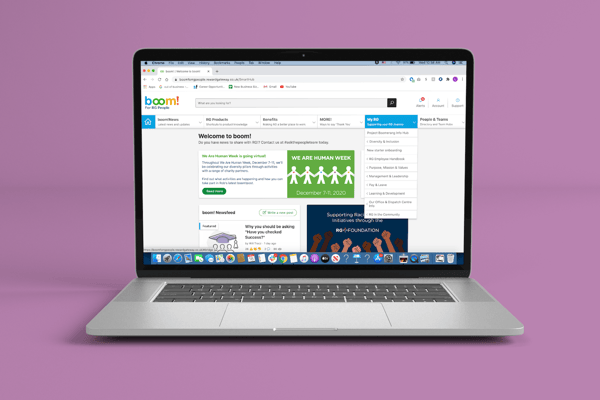
Having a one-stop-shop for all things related to the employee experience helps improve efficiency by making it easy for all employees to get to know the ins and outs of working at the company.
Showcase what ‘great’ looks like
Integrating peer-to-peer recognition within your employee engagement platform — and showcasing a social recognition wall or live feed of the eCards and awards sent across your business — means new (and existing!) employees can immediately see what "success" looks like in your organization.
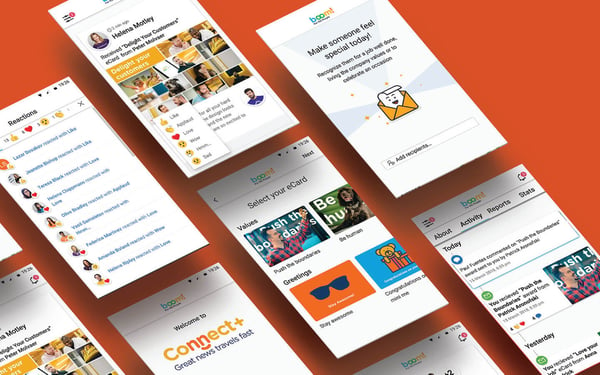
Fostering a culture of frequent, company-wide, peer-to-peer recognition is a simple but effective way of ‘teaching by example.’
Learn more about how to build a culture of continuous recognition in our latest eBook »
Keeping the flame alive
Transition in-office interactions to a digital environment
 Think about your morning routine when it comes to office or worksite life. You might bump into a colleague on your way up the elevator or have a conversation with someone on your way to your work station. Maybe it starts with a stand-up team meeting and leaders letting their people know important announcements or setting the priorities for the day.
Think about your morning routine when it comes to office or worksite life. You might bump into a colleague on your way up the elevator or have a conversation with someone on your way to your work station. Maybe it starts with a stand-up team meeting and leaders letting their people know important announcements or setting the priorities for the day.
Now think about what your morning looks like when working from home. Do you pour yourself a coffee, sit down at your desk and open your inbox? Or does your day start when you pick up your mobile phone and check the alerts from your apps? When you’re physically removed from your team, it doesn’t take long to feel isolated.
No matter when, where or what channel employees use to get the information they need to start their day, technology can play a role in giving people a sense of connection and sifting through the barrage of emails to deliver the most relevant messages when they need it most.
Imagine being able to push a company-wide message about site lockdowns or safety updates to employee smartphones? Or sending a department-specific announcement from the CEO and seeing immediately how many people have viewed it.
With an integrated employee communications platform, employees can receive alerts on their phone or in their inbox that takes them straight to an announcement from your local team lead or a blog from the Operations Manager. They can log into their platform to read the post (or watch the video!), and leave their reaction and start a conversation at the bottom.
Discover more tips on creating open and honest communications across your business in this eBook »
Employees can even send an eCard to any colleagues mentioned in the announcement — straight from a company blog post.
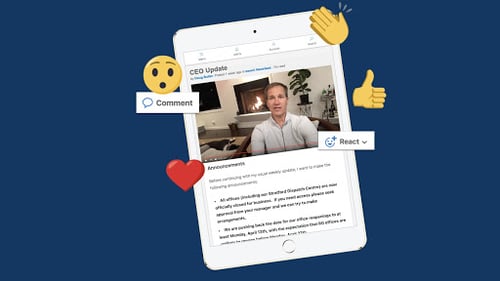
It’s been great to see how leaders are communicating across organizations of all sizes to embrace video and multimedia connect with their people through the pandemic. To the left is an example of one from our CEO — a virtual "nod" from the leadership and an opportunity to recognize someone’s good work and (in the absence of being able to give people high-fives in the lunchroom or applause at a Town Hall meeting), create a ripple effect of recognition and support digitally with an eCard or award that is published on the social wall.
Boost connection and productivity every step along the employee journey
An integrated employee engagement platform takes the unique needs of your workforce and allows you to serve the tools and widgets they’ll need to get their job done. If you work in construction, for example, that might be an RSS feed of the local weather.
You could showcase industry-specific news, your company blog or an external social media feed. You can use your platform to point to what your people need to prioritize - it could be a Safety Campaign or progress towards your mission:
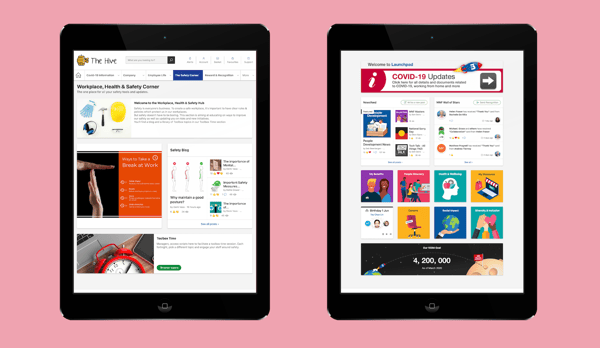
And when it’s designed to look, feel and sound like your people, you can reinforce your employer brand at every point and whenever your people access the platform: whether it’s to read company news at the beginning of their work week or during the commute home as they log on to get a discounted eGiftCard before grabbing some groceries (and a bottle of wine).
To avoid work getting too overwhelming, you can extend practical support for their physical, nutritional and mental wellbeing, even from afar, with a Wellbeing Center they can access in a few clicks: whether it’s starting the morning with a HIIT exercise video, serving up recipe inspiration during their lunch break, or winding down a tough week with a 10-minute meditation video.
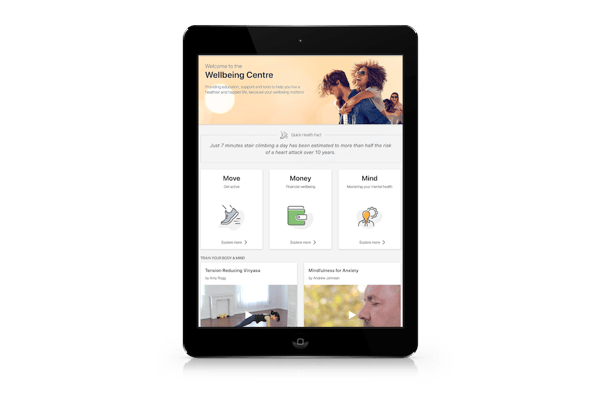
Keep communication lines open - refine and improve
Building a strong employer brand and a positive employee experience is never "done," and providing your people the channels and opportunities to provide their feedback is one way to stay connected and identify areas employees need support.
Use surveys to check-in on employee progress and wellbeing after their first week, month or 90 days, set a scheduled eNPS pulse surveyor once-off 365-degree feedback survey for managers. You can directly ask employees to tell you what they need to support their new way of working or solicit questions that help you identify what information might be missing from your communication channels.
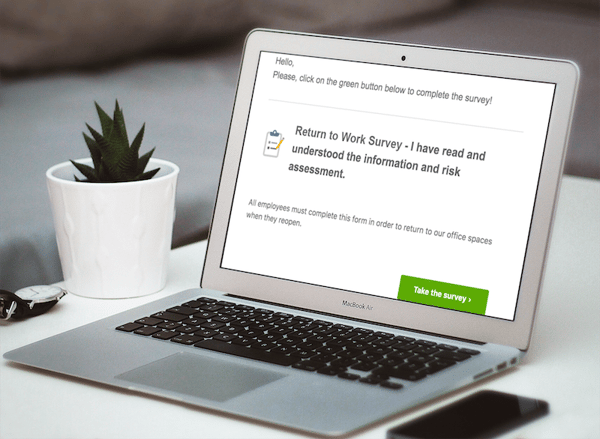
Feedback is an incredible gift that helps you make improvements along the journey.
Future-proofing the employee experience
No one could have predicted the impact and speed of change that 2020 forced on us, and there’s no way of predicting the long-term changes that will happen to our workforce in the months or years to come.
The best leaders are doing what they can to support their people and give them the tools they need to adapt to change now, by integrating employee engagement goals into their tools and technology.

These leaders intentionally create points of connection throughout employees’ work days and through the entire whole employee lifecycle, using these touch points to help boost their sense of belonging, contribution and growth. This approach will help fuel your people now, and well into the future — no matter what it has in store.

 Kylie Terrell
Kylie Terrell
